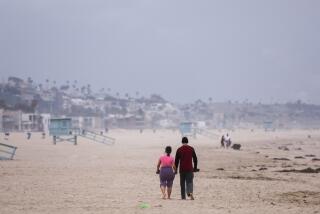A giant mass of warm water off the Pacific Coast could rival ‘the blob’ of 2014-15
A large and unusually warm mass of water is threatening to disturb the marine ecosystem along the Pacific Coast from Southern California to Alaska, scientists from the National Oceanic and Atmospheric Administration said Thursday.
They call it the Northeast Pacific Marine Heatwave of 2019, and if it doesn’t dissipate soon, researchers said it could be as destructive as the infamous “blob” of warm water that caused massive toxic algae blooms along the coast and wreaked havoc on whales, salmon, baby sea lions and other marine life in 2014 and 2015.
“Really, only time will tell if this feature will persist and if it will rival the past event in duration and impact,” said Andrew Leising, a research oceanographer at NOAA’s Southwest Fisheries Science Center in La Jolla.
Marine heat waves are defined as oceanic events in which the surface temperature of the water is warmer than 90% of past measurements for at least five days in a row.
The Northeast Pacific Marine Heatwave of 2019 currently covers about 4 million square miles of ocean surface. The affected area is roughly the shape of a triangle, with Hawaii, Alaska and Southern California as its vertices.
At its peak, the blob was just a bit bigger, covering a similar area that stretched for roughly 4.8 million square miles.
That makes the current event the second largest marine heat wave since scientists started tracking the phenomenon in 1981, NOAA researchers said.
Scientists first noticed the Northeast Pacific Marine Heatwave in June. It appears to be caused by a persistent area of low pressure in the atmosphere directly above the warm water. That low pressure led to a general weakening of the ocean winds that normally cool the water’s surface and mix that top layer with cooler water from the deep, researchers said.
However, scientists are still unsure what caused the low-pressure system to stay put for so long.
“Usually it intensifies and weakens day to day. It doesn’t sit there for months at a time,” said Nate Mantua, a research scientist at NOAA’s Southwest Fisheries Science Center in Santa Cruz. “It may not have a cause other than the chaotic motion of the atmosphere.”
Scientists said there is no evidence that climate change is responsible for the current marine heat wave, although it might have exacerbated it.
“Human-caused climate change has contributed something like 1 degree Celsius of warming across much of the North Pacific,” Mantua said. “This event is much bigger — at least 3 degrees Celsius in the last three months.”
Researchers said the 2019 marine heat wave could be even bigger than the blob, but it could also break apart.
“With the blob, the water was very warm down to 200 meters and even down below 500 meters,” said Toby Garfield, director of the environmental research division at NOAA’s Southwest Fisheries Science Center in La Jolla. “With this event right now, the heat is only in the top 50 meters, maximum.”
If the low-pressure system moves and the winds increase, the heat wave might simply break apart. However, if the winds stay low and the mass of warm water reaches the coastline, it could have the same impact as the blob, scientists said.
“It is duration and proximity to the coast that we are tracking,” Leising said.
For now, cold waters welling up from the ocean depths have held the mass of warm water offshore, but that phenomenon usually eases in the fall. Scientists say they have already seen that happen along the coast of Washington state.
It will take a few months to see whether the same thing happens farther south.







